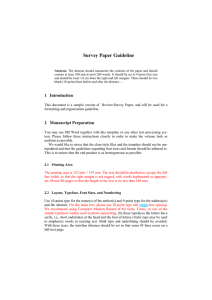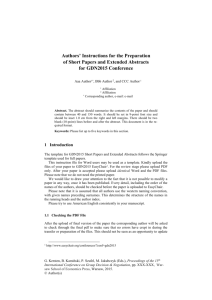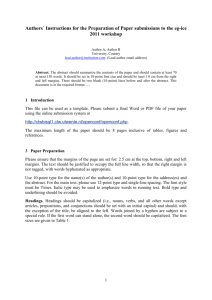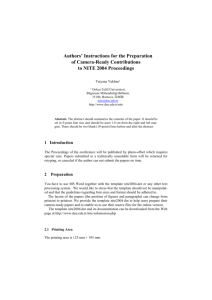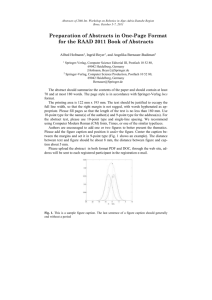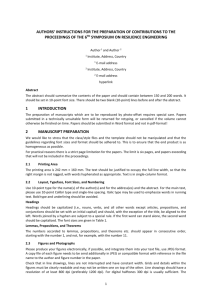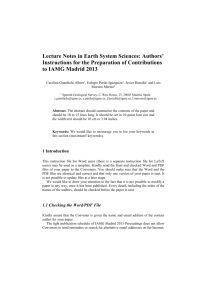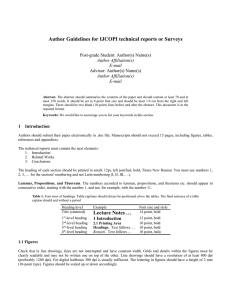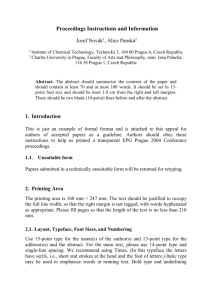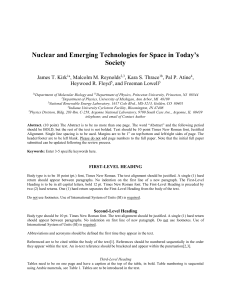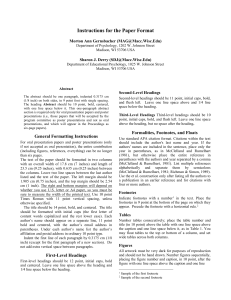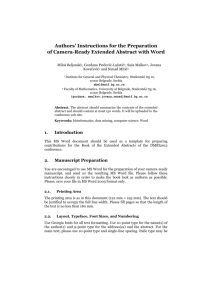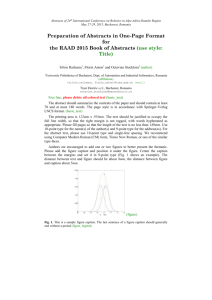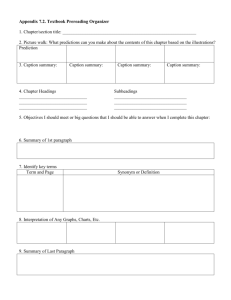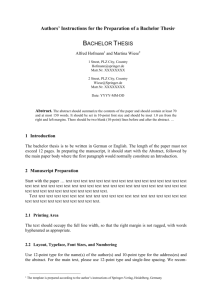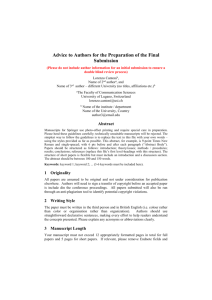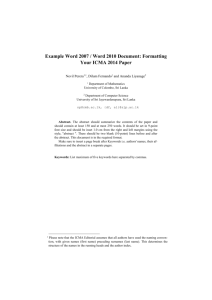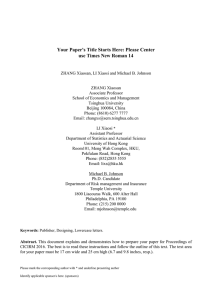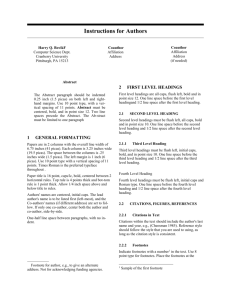sv-lncs - Université d`Orléans
advertisement
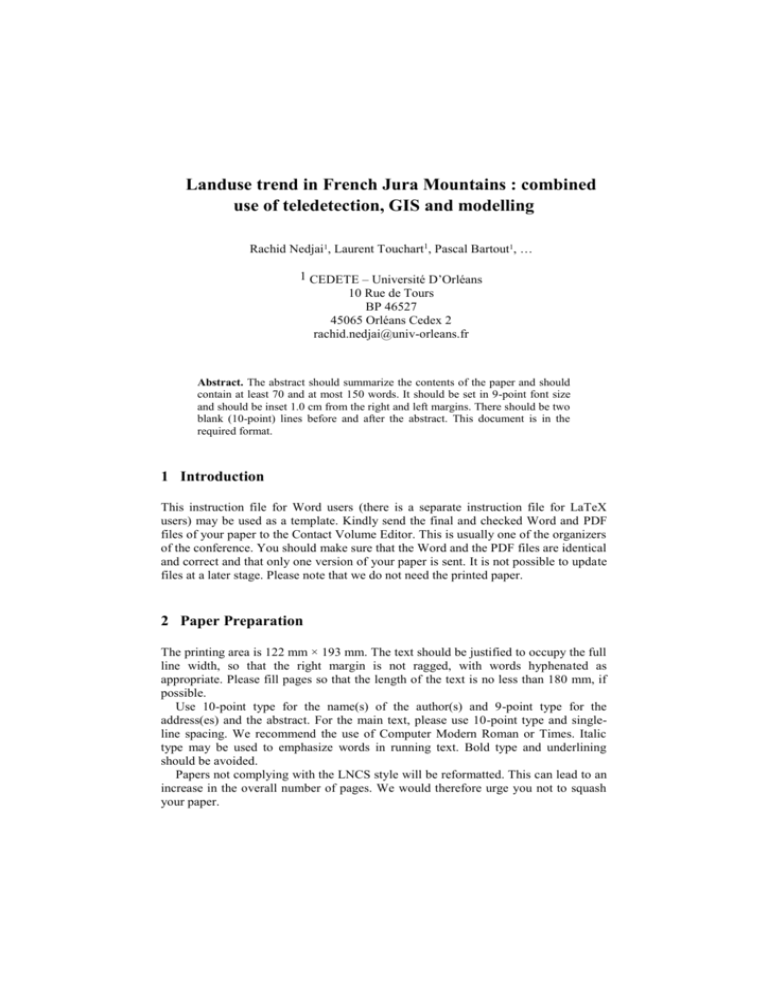
Landuse trend in French Jura Mountains : combined use of teledetection, GIS and modelling Rachid Nedjai1, Laurent Touchart1, Pascal Bartout1, … 1 CEDETE – Université D’Orléans 10 Rue de Tours BP 46527 45065 Orléans Cedex 2 rachid.nedjai@univ-orleans.fr Abstract. The abstract should summarize the contents of the paper and should contain at least 70 and at most 150 words. It should be set in 9-point font size and should be inset 1.0 cm from the right and left margins. There should be two blank (10-point) lines before and after the abstract. This document is in the required format. 1 Introduction This instruction file for Word users (there is a separate instruction file for LaTeX users) may be used as a template. Kindly send the final and checked Word and PDF files of your paper to the Contact Volume Editor. This is usually one of the organizers of the conference. You should make sure that the Word and the PDF files are identical and correct and that only one version of your paper is sent. It is not possible to update files at a later stage. Please note that we do not need the printed paper. 2 Paper Preparation The printing area is 122 mm × 193 mm. The text should be justified to occupy the full line width, so that the right margin is not ragged, with words hyphenated as appropriate. Please fill pages so that the length of the text is no less than 180 mm, if possible. Use 10-point type for the name(s) of the author(s) and 9-point type for the address(es) and the abstract. For the main text, please use 10-point type and singleline spacing. We recommend the use of Computer Modern Roman or Times. Italic type may be used to emphasize words in running text. Bold type and underlining should be avoided. Papers not complying with the LNCS style will be reformatted. This can lead to an increase in the overall number of pages. We would therefore urge you not to squash your paper. Headings. Headings should be capitalized (i.e., nouns, verbs, and all other words except articles, prepositions, and conjunctions should be set with an initial capital) and should, with the exception of the title, be aligned to the left. Words joined by a hyphen are subject to a special rule. If the first word can stand alone, the second word should be capitalized. The font sizes are given in Table 1. Table 1. Font sizes of headings. Table captions should always be positioned above the tables. Heading level Title (centered) Example 1st-level heading 2nd-level heading 3rd-level heading 4th-level heading 1 Introduction Lecture Notes … 2.1 Printing Area Headings. Text follows … Remark. Text follows … Font size and style 14 point, bold 12 point, bold 10 point, bold 10 point, bold 10 point, italic 2.1 Figures Please check that the lines in line drawings are not interrupted and have a constant width. Grids and details within the figures must be clearly legible and may not be written one on top of the other. Line drawings should have a resolution of at least 800 dpi (preferably 1200 dpi). The lettering in figures should have a height of 2 mm (10point type). Figures should be numbered and should have a caption which should always be positioned under the figures, in contrast to the caption belonging to a table, which should always appear above the table. Please center the captions between the margins and set them in 9-point type (Fig. 1 shows an example). The distance between text and figure should be about 8 mm, the distance between figure and caption about 6 mm. To ensure that the reproduction of your illustrations is of a reasonable quality, we advise against the use of shading. The contrast should be as pronounced as possible. If screenshots are necessary, please make sure that you are happy with the print quality before you send the files. Fig. 1. Landuse Trend in the Jura mountains . Elements of the figure described in the caption should be set in italics, in parentheses, as shown in this sample caption. 2.3 Footnotes The superscript numeral used to refer to a footnote appears in the text either directly after the word to be discussed or – in relation to a phrase or a sentence – following the punctuation mark (comma, semicolon, or period). Footnotes should appear at the bottom of the normal text area, with a line of about 5cm set immediately above them1. 2.5 Citations The list of references is headed “References” and is not assigned a number. The list should be set in small print and placed at the end of your contribution, in front of the appendix, if one exists. Please do not insert a pagebreak before the list of references if the page is not completely filled. An example is given at the end of this information sheet. For citations in the text please use square brackets and consecutive numbers: [1], [2], [3], etc. 1 The footnote numeral is set flush left and the text follows with the usual word spacing. 2.6 Page Numbering and Running Heads Please do not set running heads or page numbers. References 1. Baldonado, M., Chang, C.-C.K., Gravano, L., Paepcke, A.: The Stanford Digital Library Metadata Architecture. Int. J. Digit. Libr. 1 (1997) 108–121 2. Bruce, K.B., Cardelli, L., Pierce, B.C.: Comparing Object Encodings. In: Abadi, M., Ito, T. (eds.): Theoretical Aspects of Computer Software. Lecture Notes in Computer Science, Vol. 1281. Springer-Verlag, Berlin Heidelberg New York (1997) 415–438 3. van Leeuwen, J. (ed.): Computer Science Today. Recent Trends and Developments. Lecture Notes in Computer Science, Vol. 1000. Springer-Verlag, Berlin Heidelberg New York (1995) 4. Michalewicz, Z.: Genetic Algorithms + Data Structures = Evolution Programs. 3rd edn. Springer-Verlag, Berlin Heidelberg New York (1996) Appendix: Springer-Author Discount LNCS authors are entitled to a 33.3% discount off all Springer publications. Before placing an order, they should send an email to SDC.bookorder@springer.com, giving full details of their Springer publication, to obtain a so-called token. This token is a number, which must be entered when placing an order via the Internet, in order to obtain the discount.
